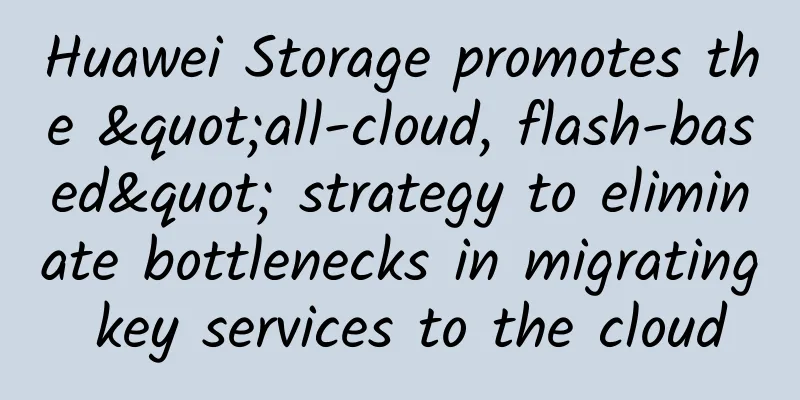Huawei Storage promotes the "all-cloud, flash-based" strategy to eliminate bottlenecks in migrating key services to the cloud

|
[51CTO.com original article] With the development of IT technologies such as cloud computing, big data, and the Internet of Things, the amount of data in enterprises has increased dramatically. How can enterprise data storage services become more efficient? How can enterprises free themselves from complex data storage management and focus on business-level innovation? How can enterprises feel the convenience brought by cloud services and migrate key businesses to the cloud securely and seamlessly?... This series of questions is bothering enterprise CIOs. To this end, as the world's only enterprise-level storage equipment supplier with public cloud business, Huawei has proposed a strategy of full cloud and full flash memory, launched the concept of storage as a service, and provided enterprise users with data storage, data protection and other products and solutions. Eliminate bottlenecks in migrating key businesses to the cloud and promote comprehensive cloud-based transformation of enterprise storage services In March this year, Huawei launched the Storage as a Service (STaaS) solution, taking the lead in the industry to create a seamless cross-cloud experience. It aims to provide enterprise businesses with storage resource services with consistent on-cloud and off-cloud experiences, as well as intelligent data services and operation and maintenance management, to help enterprise data centers evolve smoothly to the cloud. Meng Guangbin, President of Huawei's IT Storage Product Line, said: "Huawei's STaaS solution combines the storage resources of private and public clouds, allowing multiple storage resources to be used synergistically to form a flexible and secure enterprise-level storage hybrid cloud platform, allowing enterprises to more easily obtain value from data and expand their business more efficiently." At the same time, the STaaS solution also has the ability to backup data and migrate cold data to the cloud.
Meng Guangbin, President of Huawei IT Storage Product Line Recently, at HUAWEI CONNECT 2017, Huawei integrated public cloud and enterprise-level storage technologies and launched the first dedicated enterprise storage service (DESS) that supports enterprise-critical services on the cloud. The DESS launched this time is an important part of the STaaS solution. As a very important part of the STaaS solution, what problems does DESS mainly solve? From the user demand side, the transformation of enterprises to the cloud is a trend. It's just that different industries and applications have different timings and rhythms. However, according to Huawei's understanding over the years, many enterprises are medium-sized and large enterprises and have doubts about migrating key businesses to the cloud. Generally, some emerging Internet businesses are migrated to the cloud first, and traditional key businesses are still offline or in private clouds. Huawei understands that enterprise users are currently mainly concerned about security, performance, and reliability issues. The most important limiting factor in these three aspects is actually storage, which is not an exaggeration to say that it is the biggest obstacle. This is because traditional cloud service providers have less experience in storage than in computing, making it impossible for them to support the extreme reliability and performance requirements of key enterprise businesses. Meng Guangbin said that the biggest feature of DESS is that the key business of an enterprise can be seamlessly migrated to the cloud without any code modification, eliminating the biggest bottleneck for the key business of an enterprise to move to the cloud. In addition, based on the public cloud platform, DESS uses dedicated computing, network and storage resources to provide services, and is physically isolated from other businesses to ensure the security and reliability of key businesses; it provides a service capacity of up to 120,000 IOPS/LUN to meet the high-performance requirements of the key business of the enterprise; and there is no loss of key business data, and the business is not interrupted. By using DESS, enterprises do not need to build and operate complex data centers and storage devices themselves. They only need to order services on Huawei Public Cloud to enjoy secure, high-performance storage services. They can also use other services of Huawei Public Cloud to increase business flexibility, saving time and effort. Meng Guangbin said: "Huawei has a unique advantage. It can simultaneously focus on traditional enterprise storage, distributed storage, private cloud storage, and public cloud storage. We have released our years of practical experience in enterprise storage to the public cloud to support the key businesses of enterprises and provide users with a high-quality business experience. In fact, it is consistent with the experience and reliability of offline enterprises building their own data centers." Full flash memory makes key cloud services more stable and efficient Huawei has been researching flash memory since 2005, and has the ability to develop SSD chips, SSD disks, and all-flash arrays in-house. In order to ensure that key enterprise services can run more stably, reliably, quickly and efficiently after being migrated to the cloud, Huawei released a new generation of all-flash product, OceanStor Dorado V3, at the 2016 All Connect Conference. This is the first all-flash storage in China that supports NVMe technology. Huawei's new generation all-flash array OceanStor Dorado V3 OceanStor Dorado V3 uses FlashLink technology designed specifically for flash memory, achieving high performance of 4 million IOPS and 0.5ms stable low latency, allowing key services to have "0" waiting. The HyperMetro gateway-free array active-active solution achieves 99.9999% availability, and still guarantees 1 millisecond stable latency performance in active-active mode. At the same time, based on online deduplication and compression, it ensures high performance while increasing space utilization by 3 times. In addition, Huawei's self-developed chips can greatly improve the overall life and performance of SSDs, and work extensively with the CPU on the entire main controller. According to Meng Guangbin, OceanStor Dorado V3 has performed well since its release and has gained a good reputation due to the pursuit of speed and optimization requirements of low total cost of ownership by enterprise users. Taking KPN (Royal Telecom), the largest operator in the Netherlands, as an example, Huawei helped KPN build an 11PB converged storage resource pool based on the OceanStor Dorado V3 all-flash data acceleration solution, providing KPN with 6000 IOPS/TB and 0.5ms stable latency storage services for its key businesses. Through a 3:1 data reduction ratio, it further helped KPN save 40% of TCO. It can be seen that users have endless demands for flexibility, speed, and elasticity of infrastructure. Enterprises hope that both the use of resources and the storage of data can be as flexible and convenient as the use of water and electricity. Cloud computing services are precisely the ability to achieve this demand. It must be said that Huawei is a very smart, courageous, far-sighted and capable company. The strategy of full cloudification and full flash memory proposed by it has solved the storage problems of enterprise users very well. [51CTO original article, please indicate the original author and source as 51CTO.com when reprinting on partner sites] |
<<: 10 ways to deal with data center outages
Recommend
Empowering online learning, H3C University won the "Bio-Best Ecological Platform Application Award"
On November 19, 2020, the 12th CEFE China Enterpr...
If you want AI, come to Chongqing Smart Expo! Huawei brings two "magic weapons" to in-depth exchanges on the intelligent industry
[51CTO.com original article] On August 23, the th...
The Ultimate Guide to Ethernet Switch Ports: Identifying and Choosing the Right Port
Ethernet switch port types 1. Ethernet switch por...
Ruijie launches the new generation of smart classroom "A Good Class" to activate education informatization 2.0
On April 2, Ruijie Networks held a new product la...
In the new communications era, what opportunities and challenges does video compression technology face?
With the development of communication technology,...
Dubbo 3.0? No! RSocket is the eternal god
[[411111]] background The hottest topic in the do...
BandwagonHost adds Netherlands (China Unicom line) VPS, 2.5-10Gbps bandwidth, quarterly payment starts from $46.7
BandwagonHost recently added VPS products for Chi...
July operating data of the three major operators: 5G becomes the "driving force" of growth, with the number of users exceeding 500 million
Recently, the three major operators have released...
BandwagonHost: Los Angeles CN2 VPS annual payment starts at $46.7, 2.5-10Gbps bandwidth CN2 GIA line quarterly payment starts at $46.7
BandwagonHost VPS belongs to the old IT7 company....
IPv6, the savior of the Internet of Things industry?
On November 26, 2019, all IPv4 addresses were all...
CloudCone New Year Promotion, Los Angeles MC Data Center VPS Annual Payment Starting from $9.99
CloudCone has launched a Hashtag 2022 VPS promoti...
NVIDIA Launches New Spectrum-X Networking Platform to Provide High-Performance Network Solutions for Generative AI
With the popularity of generative AI, most compan...
Understand TCP, UDP and port numbers in 10 minutes
When we start learning network programming, we fi...
Why did Facebook insist on changing its name when it was clearly taboo? Two reasons for the change
Facebook changed its name to Meta, causing its st...
3 Reasons Your IoT Needs SD-WAN
We live in an era of fast-paced digital transform...









